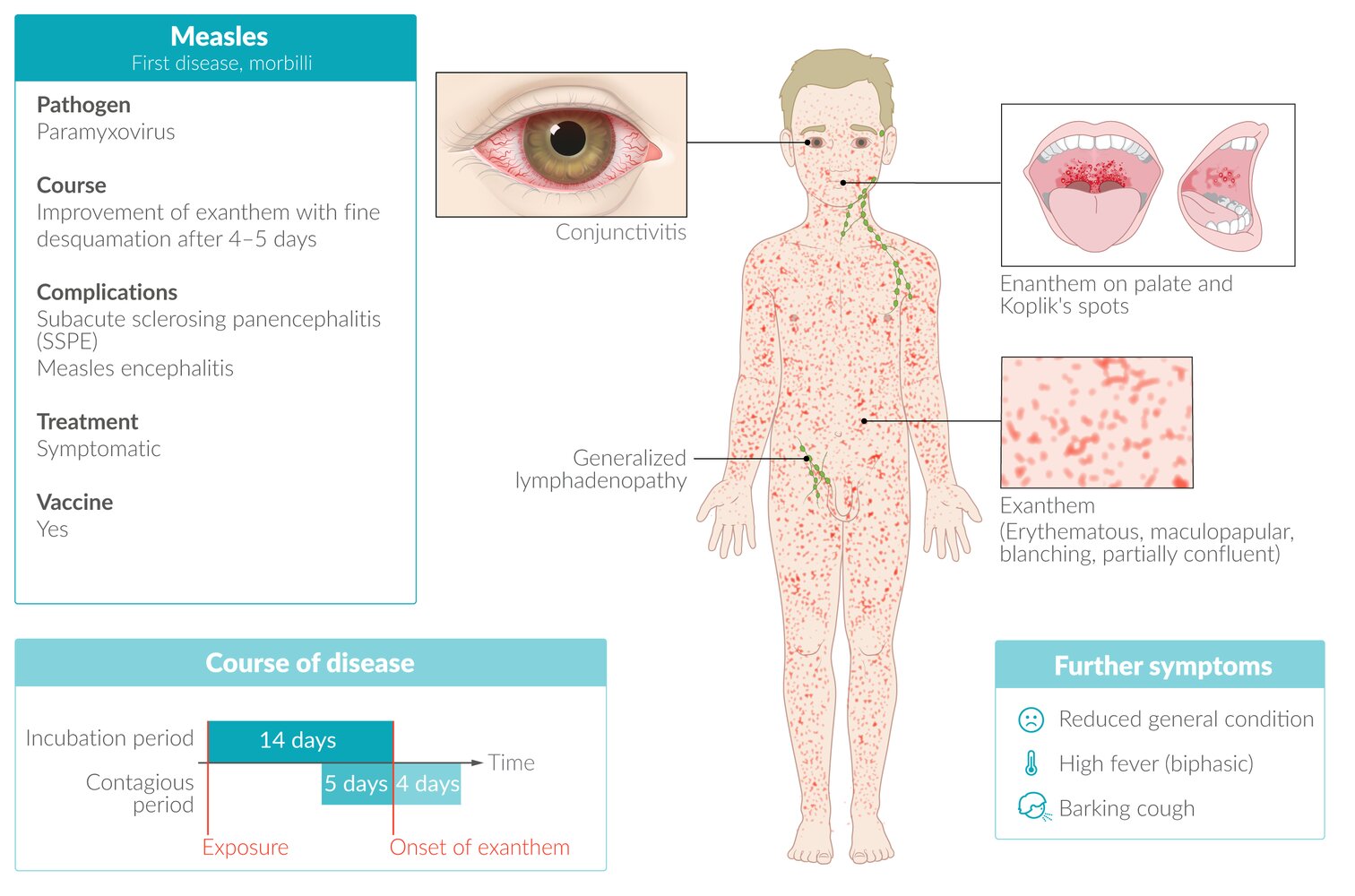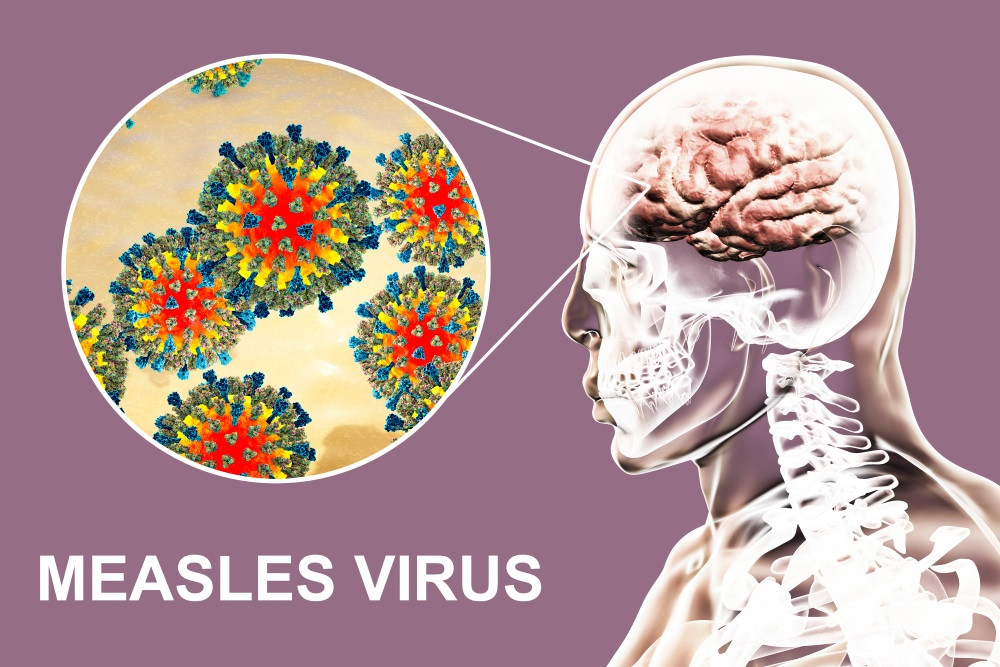By Frangiska Mylona,
The Rubeola virus is the viral agent which causes measles, one of the most acute and highly infectious diseases which is quite common in infants and young children. It belongs to the Paramyxovirus family and is characterized by its high contagious ability.
The aforementioned family contains enveloped, pleomorphic viruses with linear, negative sense, single-stranded, non-segmented RNA and antigenic stability. Moreover, they are transmitted via inhalation of respiratory secretions and regarding their peculiar characteristics, they have a common F (fusion) protein, causing the infected cells to fuse together and to form multinucleated giant cells.
The symptoms start after the incubation period, which usually lasts for two weeks. The patients present with high fever, cough, coryza conjuctivitis and Koplik spots; small red lesions with a bluish-white center in the buccal mucosa. There is also the characteristic measles maculopapular rash, that usually appears 48 hours after the Koplik spots, which is erythematous, starting from the head and continuing to the rest of the body.

One serious late-onset complication of measles is the subacute sclerosing panencephalitis. It is a rare and fatal, progressive neurodegenerative disease that develops in seven to ten years after the initial measles infection. The viruses can persist for years inside the brain, and, by forming defective forms which cannot be attacked by the immune system, along with the unchanged viruses, they are able to provoke inflammatory processes, resulting in this form of panencephalitis. The most common affected brain areas are the white matter of the cerebral hemispheres, the frontal and the occipital lobes, the thalamus, the hypothalamus, the nuclei in the pons base as well as the cerebellum.
There are some common symptoms for this disease, with dementia being the initial one. The patient will experience progressive mental deterioration, mood swings and temper outbursts with loss of interests and deep personality impairment. Additionally, several types of hyperkinesias are observed which are, typically, short-lasting and sharp, described as an “electric current”. These movements are most often myoclonic or ballistic and, from time to time, a characteristic type of mouth opening can be observed, resembling a “fish out of water”, along with a characteristic type of cry, sounding similar to a seagull. The muscle tone is also affected and gradually progresses to rigid hypertension. Epileptic seizures are also reported, which can be partial or generalized tonic-clonic type. Lastly, hypothalamic syndrome symptoms can be observed with hyperhidrosis, salivation, anorexia or bulimia and a very high fever that can reach up to 42 degrees Celsius.
For the diagnosis, apart from the clinical image, an electroencephalogram (EEG) is performed as well as lumbar puncture for cerebrospinal fluid analysis. The fluid analysis will show high titter of measles’ antibody, and the CSF electrophoresis usually shows elevated IgG immunoglobulins. Unfortunately, there is no definitive treatment for this disease. Patients usually succumb from the hyperpyrexia, coma and decerebration. The treatment is supportive and symptomatic, including Vitamin A, as WHO recommends, since it is proved that it helps in reducing morbidity and mortality.

Once again, prophylaxis is the only possible way to protect oneself from this virus and its complications. It is recommended for all children, health care workers as well as international travelers, to be vaccinated with the live measles vaccine. There are several forms of this vaccine like its monovalent form, as well as its combined form with the live attenuated rubella vaccine (MR) or additionally, with the live attenuated rubella and mumps vaccines (MMR), and also along with the live attenuated varicella vaccine (MMRV). There are mild reactions to these vaccines, however studies show that they offer lifelong immunity, since the vaccine-induced antibodies can persist for up to 33 years. Only a few groups of people are contraindicated for getting the vaccines, including pregnant women, patients with egg or neomycin allergies.
Measles is one of the major causes of children mortality around the 5th year of age in developing countries, depicting its severity along with the vital importance of vaccination. This disease does not only heavily affect the patient during the course of the initial infection, but, in some cases, the rubeola virus “re-attacks”, like in the cases of subacute sclerosing panencephalitis, where, unfortunately, there is no definitive cure, apart from the supportive one, resulting in fatal consequences for the affected individual.
References
- Stefan Riedel et al. Jawetz, Melnick & Adelberg’s Medical Microbiology, International 28th edition. McGraw-Hill Education.
- Penko Shotekov. Neurology English Edition 2015. Arco.
- Theodore X. O’Connell MD et al. Crush Step 1: The Ultimate USMLE Step 1 Review 2nd Edition. Elsevier.




